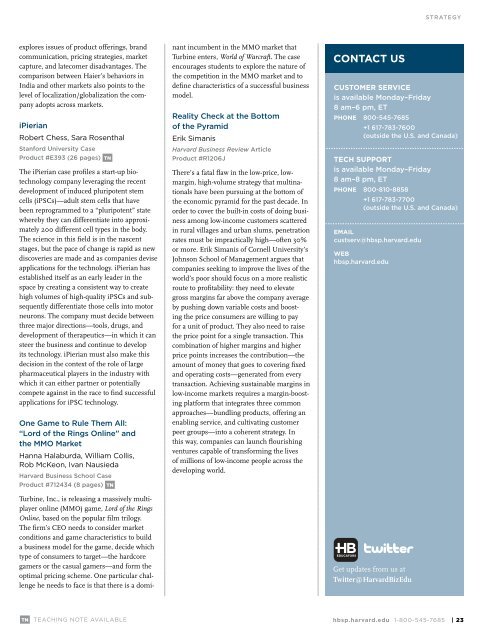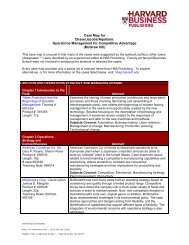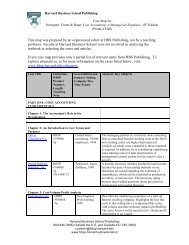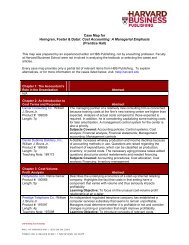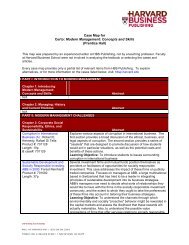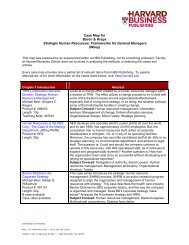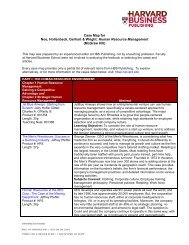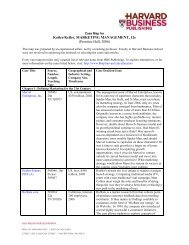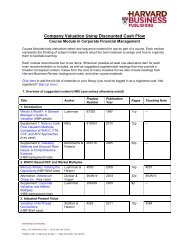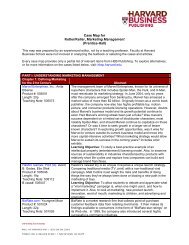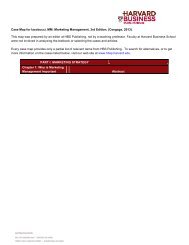teAcHing MATErIAlS - Harvard Business School Press
teAcHing MATErIAlS - Harvard Business School Press
teAcHing MATErIAlS - Harvard Business School Press
You also want an ePaper? Increase the reach of your titles
YUMPU automatically turns print PDFs into web optimized ePapers that Google loves.
explores issues of product offerings, brand<br />
communication, pricing strategies, market<br />
capture, and latecomer disadvantages. The<br />
comparison between Haier’s behaviors in<br />
India and other markets also points to the<br />
level of localization/globalization the company<br />
adopts across markets.<br />
iPierian<br />
Robert Chess, Sara Rosenthal<br />
Stanford University Case<br />
Product #E393 (26 pages) tn<br />
The iPierian case profiles a start-up biotechnology<br />
company leveraging the recent<br />
development of induced pluripotent stem<br />
cells (iPSCs)—adult stem cells that have<br />
been reprogrammed to a “pluripotent” state<br />
whereby they can differentiate into approximately<br />
200 different cell types in the body.<br />
The science in this field is in the nascent<br />
stages, but the pace of change is rapid as new<br />
discoveries are made and as companies devise<br />
applications for the technology. iPierian has<br />
established itself as an early leader in the<br />
space by creating a consistent way to create<br />
high volumes of high-quality iPSCs and subsequently<br />
differentiate those cells into motor<br />
neurons. The company must decide between<br />
three major directions—tools, drugs, and<br />
development of therapeutics—in which it can<br />
steer the business and continue to develop<br />
its technology. iPierian must also make this<br />
decision in the context of the role of large<br />
pharmaceutical players in the industry with<br />
which it can either partner or potentially<br />
compete against in the race to find successful<br />
applications for iPSC technology.<br />
One Game to Rule Them All:<br />
“Lord of the Rings Online” and<br />
the MMO Market<br />
hanna halaburda, William Collis,<br />
Rob McKeon, ivan Nausieda<br />
<strong>Harvard</strong> <strong>Business</strong> <strong>School</strong> Case<br />
Product #712434 (8 pages) tn<br />
Turbine, Inc., is releasing a massively multiplayer<br />
online (MMO) game, Lord of the Rings<br />
Online, based on the popular film trilogy.<br />
The firm’s CEO needs to consider market<br />
conditions and game characteristics to build<br />
a business model for the game, decide which<br />
type of consumers to target—the hardcore<br />
gamers or the casual gamers—and form the<br />
optimal pricing scheme. One particular challenge<br />
he needs to face is that there is a domi-<br />
tn TEAChiNG NOTE AVAiLABLE<br />
nant incumbent in the MMO market that<br />
Turbine enters, World of Warcraft. The case<br />
encourages students to explore the nature of<br />
the competition in the MMO market and to<br />
define characteristics of a successful business<br />
model.<br />
Reality Check at the Bottom<br />
of the Pyramid<br />
Erik Simanis<br />
<strong>Harvard</strong> <strong>Business</strong> Review Article<br />
Product #R1206J<br />
There’s a fatal flaw in the low-price, lowmargin,<br />
high-volume strategy that multinationals<br />
have been pursuing at the bottom of<br />
the economic pyramid for the past decade. In<br />
order to cover the built-in costs of doing business<br />
among low-income customers scattered<br />
in rural villages and urban slums, penetration<br />
rates must be impractically high—often 30%<br />
or more. Erik Simanis of Cornell University’s<br />
Johnson <strong>School</strong> of Management argues that<br />
companies seeking to improve the lives of the<br />
world’s poor should focus on a more realistic<br />
route to profitability: they need to elevate<br />
gross margins far above the company average<br />
by pushing down variable costs and boosting<br />
the price consumers are willing to pay<br />
for a unit of product. They also need to raise<br />
the price point for a single transaction. This<br />
combination of higher margins and higher<br />
price points increases the contribution—the<br />
amount of money that goes to covering fixed<br />
and operating costs—generated from every<br />
transaction. Achieving sustainable margins in<br />
low-income markets requires a margin-boosting<br />
platform that integrates three common<br />
approaches—bundling products, offering an<br />
enabling service, and cultivating customer<br />
peer groups—into a coherent strategy. In<br />
this way, companies can launch flourishing<br />
ventures capable of transforming the lives<br />
of millions of low-income people across the<br />
developing world.<br />
contAct us<br />
customer service<br />
is available Monday–Friday<br />
8 am–6 pm, ET<br />
pHone 800-545-7685<br />
+1 617-783-7600<br />
(outside the U.S. and Canada)<br />
tecH support<br />
is available Monday–Friday<br />
8 am–8 pm, ET<br />
pHone 800-810-8858<br />
+1 617-783-7700<br />
(outside the U.S. and Canada)<br />
emAil<br />
custserv@hbsp.harvard.edu<br />
weB<br />
hbsp.harvard.edu<br />
EDUCATORS<br />
Get updates from us at<br />
Twitter@<strong>Harvard</strong>BizEdu<br />
STRATEGY<br />
hbsp.harvard.edu 1-800-545-7685 | 23


